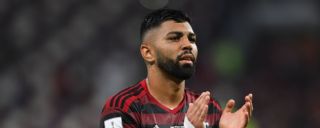|
Can Gabriel Barbosa buck the trend? With 45% of the vote, the Brazilian striker has just been announced as South America's player of the year in the prestigious annual survey organized by the El Pais newspaper in Uruguay. He has enjoyed a wonderful year: top scorer in the Copa Libertadores with nine goals, including the two in the last few minutes of the final against River Plate that turned defeat into victory, and top scorer in the Brazilian Championship with 25 goals in Flamengo's joyful procession to the title. With a total of 43 goals in 2019, a charismatic bond formed not only with Flamengo fans but with supporters from all over the country. It was a remarkable year, but what happens now? It may be regrettable, but it is impossible to disagree: the best players from the four corners of the globe end up in top-tier European football. A large part of this, of course, is motivated by financial considerations, but there's something else to it as well. Club football in Europe is where the great players prove themselves as great. It is where they win each other's respect. This process -- the talent drain -- has had an obviously negative effect on club football in South America, the continent that continues to serve as a magnificent production line of footballing talent. It seems that the South American game is now populated by three types of player: youngsters on the way to Europe, veterans who have come back and those in the middle who have not been deemed good enough to receive the call. And this third category now appears to include the best players in South America, those in their mid-20s that Europe does not want. This would seem to apply to the past two winners of the El Pais award. The 2017 victor was Luan of Gremio, whose career has not kicked on and who will attempt to regain momentum with Corinthians in 2020. It also applies to last year's winner, Gonzalo "Pity" Martinez. There was some interest from smaller clubs in Europe but he, of course, ended up with Atlanta United in Major League Soccer. So what awaits Gabriel Barbosa? The striker has already had a go at Europe, and was a resounding failure, doing nothing of note in his time with Inter Milan and Benfica. This may not have entirely been his fault. Inter Milan, especially, have made a habit of not getting the best out of expensively acquired talent until recently. But there would seem to be three other explanations for his first-time failure, question marks that have not entirely disappeared despite his triumphant time in the past few months. One is his temperament. Gabriel Barbosa's time in Europe was dogged by complaints about his attitude, and there's always been something of the spoiled kid about him. He had been treated as a special talent as he made his way up the youth ranks at Santos, but it seemed very hard for him to cope with being just one more in the deep squad of a top European club. He now says that at the age of 23, he is more mature. That claim has to be doubted given the number of cards he has picked up this year, the majority for excessive petulance. Then there is the question of his position on the field. Like so many strikers, Gabriel Barbosa has been a victim of the recent trends for 4-2-3-1 and 4-3-3. He has some skills of a winger, but he is not a winger. He has some skills of a centre-forward, but is not an out-and-out centre forward. He likes to drop deep, find space and wander across the attacking line. Like his strike partner Bruno Henrique, he has benefited enormously from the 4-4-2 system that Jorge Jesus has used at Flamengo. That formation has brought out the best in him, which leads to the third doubt. Is his best good enough? He got little change out of Virgil Van Dijk in the recent Club World Cup final against Liverpool. Is he too dependent on his left foot to be a consistent threat to the best defences? The latter, of course, is the question that can only be answered if he returns to Europe, a choice that will be going round his head at the moment. Gabriel Barbosa is adored at Flamengo and is respected across Brazil, and can only be happy being at the sharp end of the collective party that his club have been enjoying in the last few months. But at the age of 23, he will not have many other opportunities to prove he can be a hit at the highest level. He is still on loan from Inter Milan; should he aim to go back across the Atlantic, or encourage Flamengo to step up and buy him? He may feel that there is a way to square the circle, to stay in South American club football and still prove that he is a world-class player. That route would run through the national team. Given a handful of Brazil caps in 2016, Gabriel Barbosa was recently recalled to the squad, though club commitments prevented him from gaining any traction. But 2020 could be different. There's the start of the World Cup qualification campaign and a Copa America in the summer, plus the fact that Brazil's centre-forward position is up for grabs. Gabriel could stay at home and still be given the No.9 shirt. The only problem here is that there will be a long wait before he faces the best: all of Brazil's recent World Cup campaigns have ended in a knockout round defeat against European opponents. Is Gabriel Barbosa prepared to wait until the end of 2022 to prove that he is a genuinely world-class striker?
|

